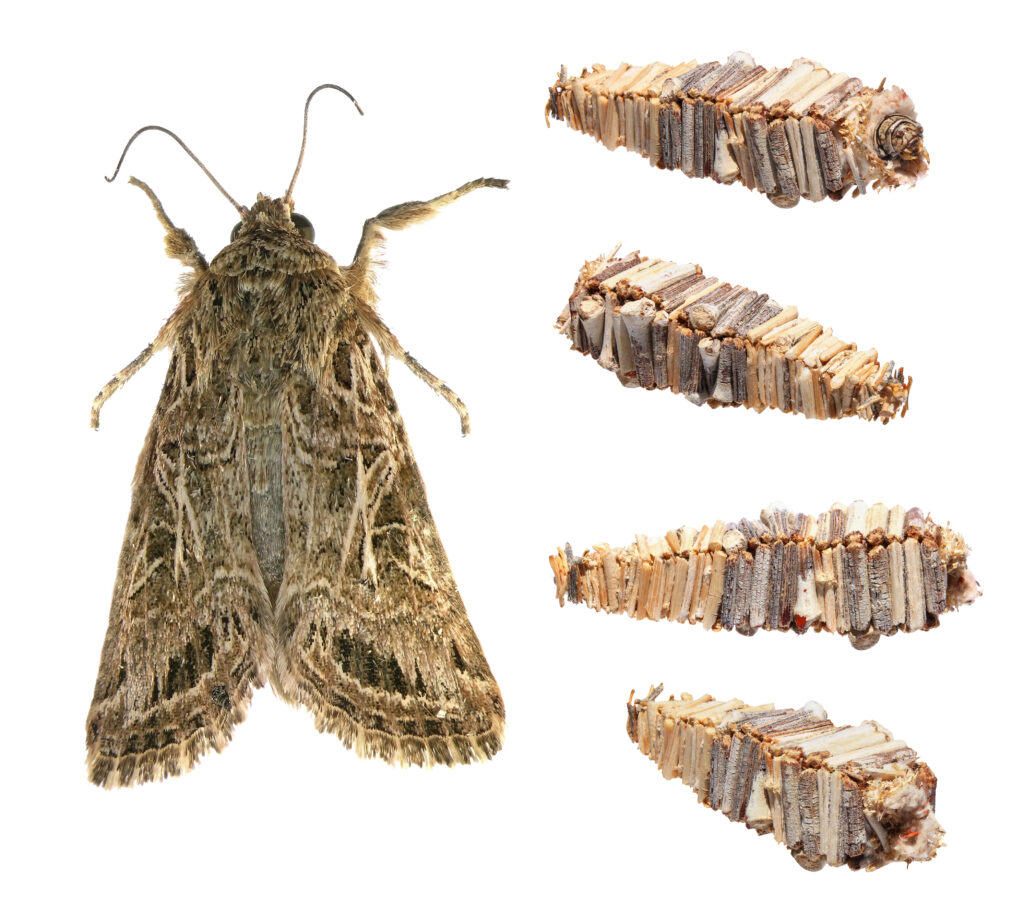Bagworm Moth
There are approximately 1350 species in the bagworm moth family (Psychidae), which forms part of the order Lepidoptera.
Advertisement
Bagworm Moth Scientific Classification
Read our Complete Guide to Classification of Animals.
Bagworm Moth Conservation Status
Bagworm Moth Facts
- Name Of Young
- Caterpillar
- Group Behavior
- Infestation
- Fun Fact
- There are approximately 1350 species in the bagworm moth family (Psychidae), which forms part of the order Lepidoptera.
- Biggest Threat
- Humans
- Most Distinctive Feature
- Females live in protective sacs all their lives
- Wingspan
- 25 millimeters
- Habitat
- Evergreens and numerous other shrubs and trees
- Predators
- Birds and insects
- Diet
- Herbivore
- Lifestyle
- Diurnal
- Common Name
- Bagworm moth
- Origin
- North America
- Number Of Species
- 1350
Bagworm Moth Physical Characteristics
View all of the Bagworm Moth images!
Bagworm moths are a family of moths belonging to the order Lepidoptera and are known for their protective larval cases. These moths are found worldwide, but primarily in North America and Africa. There are two subspecies in this family that are especially notorious in North America called the evergreen bagworm and Abbot’s bagworm moth.
These moths undergo seven stages called instars during their lifecycle before they emerge as a fully transformed adult. However, they mainly eat during their larval stage and don’t feed as adults. Once they reach sexual maturity, all they do is mate and lay eggs before they die.
Bagworm Moth Facts
- Bagworm larvae are well-known pests of evergreens and numerous other shrubs and trees in North America.
- Once inside their cocoons, it takes approximately two to three weeks to transform into an adult bagworm moth.
- To reduce small infestations of these moths, introduce natural predators like woodpeckers or wasps.
Bagworm Moth Species, Types, and Scientific Name
There are approximately 1350 species in the bagworm moth family (Psychidae), which forms part of the order Lepidoptera. The three most well-known species are as follows:
Common Bagworm Moth (Psyche casta)
Common bagworm moths are nocturnal and have a wingspan of 12 to 15 millimeters. Additionally, they have metallic brown wings. However, the females are grub-like with legs, but no wings, and they are light brown or yellow. Furthermore, females stay in their protective cases.
Evergreen Bagworm Moth (Thyridopteryx ephemeraeformis)
The evergreen bagworm moths look very similar to black bees with their furry bodies and long tapering abdomen tips. Surprisingly, they have transparent wings, which is very unusual for moths, but this happens because they lose most of their wing scales when pushing their way out of their larval cases. Adult female evergreens don’t have wings or antennae. In fact, they look more like grubs or caterpillars than moths and generally don’t leave their cases.
Abbott’s Bagworm Moth (Oiketicus abbotii)
Abbott’s bagworm moths are native to Florida and Louisiana. They have a wingspan of approximately 33 millimeters. Additionally, adults experience sexual dimorphism, as females lack wings.
Appearance: How To Identify the Bagworm Moth

Amicta Bagworm Moth with its larvae in a protective case.
©Protasov AN/Shutterstock.com
Adult bagworm moths camouflage really well, especially the females, as they are typically encased in a protective bag that looks like twigs and leaves. Many female species of bagworm moths have small eyes and no wings or antennae. Therefore, these female moths remain in a caterpillar-like state. Once they mate, they lay their eggs inside their protective cases. Adult male bagworm moths have wings, and their charcoal-black bodies are covered in hair. Additionally, their wingspan measures 25 millimeters long.
The adult female bagworm moth can live for several weeks, but adult males have a much shorter lifespan of only one to two days.
Habitat: Where to Find the Bagworm Moth
Bagworm larvae are well-known pests of evergreens and numerous other shrubs and trees in North America. It is very rare to see winged males because they only live for a couple of days. But, they will flock towards lights in summer and fall. It is easier to find the larvae and females as they are encased in a protective bag. Surprisingly, larvae can travel far distances between plants before they reach their pupate stage.
Diet: What Do Bagworm Moths Eat?
Bagworm moth caterpillars feed on the stems and leaves of various shrubs and trees, especially evergreens. In certain states, they are often found feeding on eastern red cedars and junipers.
Bagworm Moth Lifecycle
The Bagworm moth starts its lifecycle as an egg. In fact, these moths can lay hundreds of eggs inside their protective sacs during the summer and early fall. The eggs incubate inside the sac throughout winter, which they share with their deceased mother. Once spring arrives, they hatch into caterpillars.
At first, the caterpillars will feed, then they begin to build their protective cases from the shrubs or trees they live on. They occasionally hang from trees on silk threads during their early life, right before they start constructing their cases, making them easy to spot. Once their sacs are complete, the caterpillars will climb inside them, with just their heads and feet protruding. Then, as they grow inside the case, they will drag it around to find food while adding extra silk and vegetation to the sac as they go. The caterpillars will develop in their cases throughout the spring and early summer until about mid-summer when they begin to spin a cocoon inside their sacs. Once inside their cocoons, it takes approximately two to three weeks to transform into an adult moth.
Male bagworms will start to evacuate their cocoons in late summer and take off in search of females immediately. After a few days of mating, the male moth dies.
Prevention: How to Get Rid of Bagworm Moth
There was a time when the only advice on eliminating a bagworm infestation was to pick each case from the shrub or tree individually. While this method is effective, it is not a viable solution when there is a large landscape and hundreds of sacs occupying the trees. However, today, there are several ways to prevent or remove bagworms from your garden.
Pick Them Off One by One
As mentioned above, this is an effective method when there is only a small infestation. Pick the cases from the trees one by one and discard them in warm, soapy water. If these pests are on high branches, it’s best to employ a professional to take care of this mammoth task for you.
The best time to carry out this technique is from October to March, which ensures you remove all the egg-filled sacs.
Encourage Natural Predators
Another harmless way to reduce small infestations is by introducing natural predators. There are several species of birds and insects that will make a feast of these pesky caterpillars. In fact, woodpeckers are incredibly skilled at cracking open protective cases to get to the eggs inside. Additionally, sparrows are another excellent option to keep around. So, to entice these birds to your garden, install bird baths, feeders, and shelter, and avoid pesticides. Another worthy predator is the wasp, as they will lay their eggs inside these protective sacs, and once their offspring hatches, they will start to eat the eggs.
Bacillus Thuringiensis Spray (BT)
BT is an excellent naturally occurring bacteria that make these caterpillars so sick that they stop eating and eventually die. Only use BT once the eggs start hatching and the caterpillars emerge from the sacs, which generally occurs in May or June.
Chemical Controls
This method is only recommended for serious bagworm moth infestations on large landscape trees. The best chemicals to use on these caterpillars are:
- Cyfluthrin
- Acephate
- Spinosad
Spray any of these chemicals onto the infected area. However, spinosad is the safest one to use because it isn’t as toxic to humans as the others. However, all of these chemicals are toxic to bees and other vital insects, so use them responsibly. Therefore, only apply on days without wind so it can dry fast and not float away to other areas.
Related Animals
View all 285 animals that start with BBagworm Moth FAQs (Frequently Asked Questions)
Is a Bagworm poisonous?
No, bagworms are not poisonous. They cause the death of plants due to feeding on their foliage.
What do bagworms turn into?
The Bagworm moth starts its lifecycle as an egg. In fact, these moths can lay hundreds of eggs inside their protective sacs during the summer and early fall. The eggs incubate inside the sac throughout winter, which they share with their deceased mother. Once spring arrives, they hatch into caterpillars. Once inside their cocoons, it takes approximately two to three weeks to transform into an adult moth.
What is the best treatment for bagworms?
Pick the cases from the trees one by one and discard them in warm, soapy water. If these pests are on high branches, it’s best to employ a professional to take care of this mammoth task for you.
The best time to carry out this technique is from October to March, which ensures you remove all the egg-filled sacs.
Thank you for reading! Have some feedback for us? Contact the AZ Animals editorial team.
Sources
- Wikipedia, Available here: https://en.wikipedia.org/wiki/Bagworm_moth
- Britannica, Available here: https://www.britannica.com/animal/bagworm-moth#:~:text=bagworm%20moth%2C%20(family%20Psychidae),%2C%20twigs%2C%20and%20other%20debris.
- The University of Florida, Available here: https://entnemdept.ufl.edu/creatures/MISC/MOTHS/bagworm.htm

















